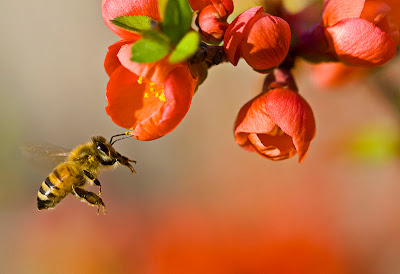One of the best signs of spring is the return of the honeybees! Here is a picture I snapped of one of the first honeybees to visit the garden in 2013. I'm not a professional photographer, so excuse the poor image.
Honeybees are not native to the Western Hemisphere but were introduced to North America by European settlers in the early 17th century. Since that time, they have become fundamentally interwoven with the fabric of American agriculture and ecology.
For most people, the first thought of honeybees is understandably the production of honey. Around the time of the Civil War, honey was only just becoming a commercially viable agricultural product. In earlier times, harvesting honey meant destroying the bees and their hives. Several 19th century innovations, especially the movable frame or Langstroth hive, made honey production sustainable and affordable.
After the Civil War, other inventions like the centrifugal honey extractor (1865) and the hand-held smoker (1875) would continue to make bee-keeping a more practical venture.
Honey is a very unique food. It has been argued that honey is the only food which humans eat that has been manufactured by another animal. If stored properly, honey will last indefinitely, for centuries or more! It is also widely understood to promote healing in burns and cuts, also possessing powerful antibiotic properties. Some people will use it in place of antibiotic ointment in dressing minor wounds.
While most people love honey, that is only a small fraction of what makes honeybees vital to our modern existence. Honeybees are the largest pollinators in the United States. According to the U.S. Department of Agriculture, honeybees are responsible for pollinating 80% of all flowering crops, which constitutes at least 1/3 of America's food supply.
Alarmingly, honeybees are in serious trouble. Pesticides introduced in the 20th century often have the unintended effect of killing bees that visit crop fields. The arrival of invasive parasitic mites has also been detrimental to honeybee colonies. Currently the greatest threat to bee survival is a phenomenon known as "Colony Collapse Disorder," in which most of the bees in a hive disappear suddenly without any apparent provocation. Theories abound to explain the cause, including pesticides, parasites, genetic faults, and electromagnetic radiation.
Honeybees in the Pry Garden's lavender last June








No comments:
Post a Comment